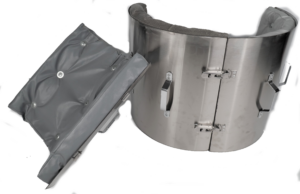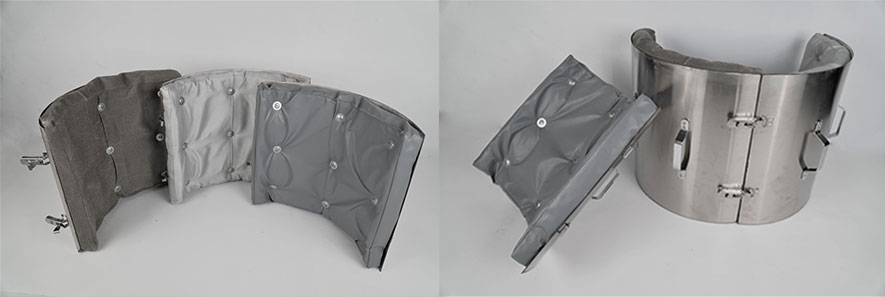Nuclear facilities, where most of the energy produced is obtained through nuclear reactions, harmful substances that can harm the environment for many years are also released. Therefore, the safe and sustainable operation of nuclear facilities is extremely important to keep possible environmental pollution under control. Industrial insulation systems play an important role in the safe and sustainable operation of nuclear facilities.

There are two main systems in nuclear power plants, they are called Nuclear Island and Turbine Island. The Nuclear Island is the restricted zone within the boundaries of the Containment, where the nuclear reaction takes place. The Turbine Island, on the other hand, is the whole of the systems in which the steam (sometimes pressurized water or heavy water) produced by the heat energy obtained by the nuclear reaction is converted into electrical energy. Apart from these, we can also talk about a third main system called BOP (Balance of Plant), which includes all auxiliary components other than these systems. All these main systems have industrial insulation applications.

In the maintenance and repair activities of the facility, removable flexible insulation systems are generally used in nuclear facilities so that the insulation can be easily disassembled and reassembled in the same way after the operation, especially in cases where emergency intervention is required. This is where the biggest difference lies compared to industrial insulation applications in other power plants or similar process facilities. Because the urgency of maintenance and intervention in nuclear facilities is many times higher than in all other facilities due to high environmental risk factors.
Removable insulation systems are a type of industrial insulation lining that can be applied to the surfaces of equipment, pipelines, valves and other components in nuclear facilities. It is designed so that when there is a need for intervention on the insulated component (pipe, equipment, etc.), it can be disassembled locally or completely and easily reassembled when the process is completed. For this reason, it is essential that any module should not exceed a certain weight level (usually 20-25 kg). In addition, there are important parameters to be considered in the design, manufacturing and assembly processes of removable isolation systems used in nuclear facilities. The parameters considered in the design of conventional insulation systems, especially thermal insulation capability, acoustic insulation capability, waterproofing, resistance to chemical or similar corrosive substances, fire resistance and even passive fire protection, are also taken into account in nuclear facility insulations. However, the most important difference at this point is the applications in the Nuclear Island zone of the facility, which is also called the Containment. When these applications are compared with conventional insulation systems, there is almost a whole other universe of parameters considered. Containment; is a large zone that includes the nuclear steam supply system (NSSS), which may consist of a reactor, piping, pumps, valves and other miscellaneous components and equipment. NSSS has a very large net positive heat load. The insulation on the hot service piping and equipment inside the containment has one purpose; “controlling cooling loads.” Whether connected directly to a body of water (e.g., river, lake, sea, etc.) or to vapor compression cooling (air conditioning), the cooling system must remove this heat.
In nuclear power plants, mostly mineral wool, calcium silicate, fiberglass, nanogel and similar microporous products are used as insulation materials, various refractory materials when necessary, and reflective metallic materials or technical textiles with fireproof properties are used as claddings. Cassette type insulation modules (figure-1) produced with metal cladding materials have recently been replaced by completely removable insulation jackets made of fireproof fiberglass material (figure-2 and figure-3). The thermal, seismic and other safety requirements of both methods are taken into consideration during the design phase, and they are produced as such. Again, in both applications, each of the modules is labelled with its own unique codes, and it is delivered with assembly drawings in which their positions are indicated with every needed detail.
Removable insulation systems can be used in the expansion or renovation projects as well as the construction of the facility. In addition, worn or damaged module or modules can be reproduced by the manufacturer.
In conclusion, removable insulation systems are an important technology that increases safety and sustainability standards in nuclear facilities. These systems ensure that the harmful substances that may arise during the operation of the facility are kept under control and that the efficiency in energy production is increased. However, it is extremely important that these systems have high design standards, the correct selection of materials, and the implementation of appropriate installation and maintenance processes.
NOTE: The content of this article is informative and useful about insulation systems in nuclear facilities. However, you should not forget that nuclear facilities are a serious and sensitive issue, and only the project designers and owners are authorized/responsible for the design and implementation of any nuclear facility. Therefore, the article should be used appropriately by citing the source and relying on completely accurate and reliable information.
Finally, due to the sensitivity of nuclear facilities, it is important for companies and experts operating in the nuclear energy sector to act carefully and responsibly for the use of the article.